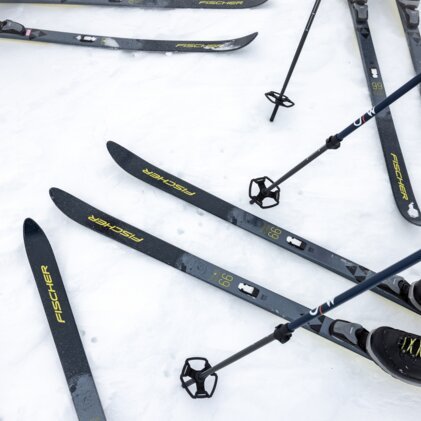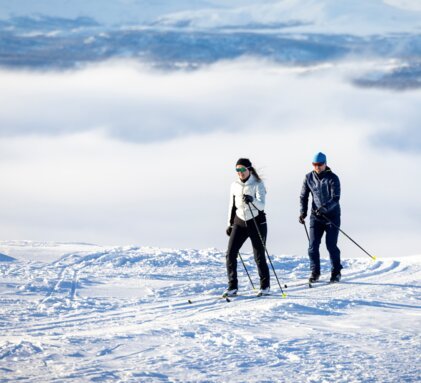
Some do it because it is a great workout. Some do it because it is a great outdoor experience. And some do it because it's – just great. What are we talking about? Cross-country skiing, of course!
Apart from the benefits just mentioned, cross-country skiing has another great advantage: It is the ideal winter sport for beginners. Why? Because you don't need expensive equipment or a lot of experience. What's more, you can start almost anywhere where there are tracks in the mountain area.
Before you hit the trails for the first time, you should know the basics of this sport. To help you get started, we have complied the best cross-country skiing tips for beginners – focusing on technique, equipment and the right preparation – enjoy reading!
What is cross-country skiing?
Cross-country skiing is the sport of gliding on special skis over groomed trails or off-piste terrain. Unlike alpine skiing, it is done under your own power with the help of poles over flat or hilly landscapes in the snow. There are two main techniques:
Classic cross-country skiing style
- Movements similar to walking
- Based on the diagonal step
- Particularly suitable for flat or slightly hilly terrain
- Less difficult to learn than skating
Skating technique
- Movements similar to ice skating
- More dynamic and powerful
- Ideal for more fit people due to higher speeds
- Particularly suitable for steeper ascents
Equipment tips for cross-country skiing beginners
Compared to other winter sports, you don't need a lot of equipment for cross-country skiing. All you need is special skis, suitable bindings, suitable boots and poles. Here is an overview of the most important things.
Cross-country skiing – overview for beginners
Choosing the right skis is crucial to guarantee a comfortable and efficient cross-country skiing experience. Depending on the technique, terrain and personal preference, there are different types of skis, varying in length, width and construction. For beginners, it is important to choose the right ski to make it as easy as possible to learn the classic technique or to skate. Here is an overview of the most important types of skis:
Classic cross-country skis
- Long and narrow with a short climbing zone
- Ideal for the classic technique on groomed trails
Backcountry skis
- Shorter, wider version of the classic ski with a longer climbing zone
- Metal edges for better grip on icy terrain
- Ideal for adventures in an untracked area off the classic trail
Skating skis
- Narrow and stiff with a smooth surface throughout
- Approx. 10 cm shorter than the classic cross-country ski
- Ideal if you want to skate
The right boots for cross-country skiing
A key factor in cross-country skiing is the comfort and efficiency of your boots. They are specially designed for your technique and provide support, flexibility and stability. It is worth knowing the characteristics of your boots to get the best support on the trails.
Classic boots
- Soft outsole for a natural rolling motion
- Low boot shaft for maximum freedom of movement
- Ideal for classic cross-country skiing
Skating boots
- Stiffer outsole for more precise power transmission
- Higher boot shaft for more stability and support
Want even more helpful tips on choosing your boots? Check out our blog post on how to find the right boots!
Poles
Cross-country poles are an essential piece of equipment and play an important role in the correct movement sequence and power transmission. The optimum pole length depends on your height and your chosen technique – classic or skating. With the right poles, you can improve your technique and glide down the trail more efficiently.
Poles for classic style:
- The handle should reach up to your armpit.
- Calculation: Height in centimetres x 0.83
Poles for skating:
- The handle should reach your ear or nose.
- Calculation: Height in centimetres x 0.89
For more information and practical tips on how to choose and use cross-country poles correctly, we recommend the following blog post:
What clothing do you need for cross-country skiing?
As with almost any winter sport, the magic word for is the "layering principle". This will keep you flexible and protected from the winter conditions in the snow:
- Base layer: Functional underwear (e.g. merino wool) for optimum sweat transport
- Mid-layer: A fleece shirt to keep you warm
- Outer layer: A cross-country jacket and pants to protect you from the wind and cold
Wearing the right cross-country skiing clothing is crucial to staying warm, dry and agile during your adventures in the mountain-area. Layering is the best way to adapt to changing conditions and enjoy your winter sports to the full.
Rent cross-country skiing equipment from INTERSPORT Rent
If you want to try out cross-country skiing first without investing in a complete set of equipment, rental is the ideal option. At INTERSPORT Rent, you can hire high-quality cross-country skiing equipment – from skis and poles to boots. This way, you can hit the trails fully equipped without making a long-term commitment.
Cross country skiing: The best tips for beginners
Now that you know what you need for your first time on the trail, it's time to start learning! What's the best way to get started? Here are our top 5 tips to help you get ready for your first day on the trails:
Tip #1: Get fit with endurance sports!
You don't have to be a top athlete to learn cross-country skiing. But as with any other sport, it helps to have at least a basic level of fitness. Endurance sports such as jogging and cycling are particularly effective ways to build up your fitness.
The movements in both Nordic walking and inline skating are similar to those in cross-country skiing. While Nordic walking is similar to the classic style, inline skating is perfect if you want to skate. Both sports are therefore ideal for preparing you for your first time.
Tip #2: Take it slow – the best start for beginners!
Even if you're already a top athlete, don’t overestimate yourself! Our tip for learning cross-country skiing: Take it easy!
The classic technique is perfect for beginners. You should choose flat trails at the start to improve the balance and develop a feel for the gliding movement.
Tip #3: Learn the cross-country skiing technique from the pros!
This winter sport may look easy. But it can be quite strenuous if you get the technique wrong. In classic cross-country skiing, it is important to make the right moves at the right time. That way, you can optimize your glide from the start and won't be out of breath after just ten minutes.
Cross-country skiing lessons for beginners
If you are new to cross-country skiing, it is a good idea to take a special course before embarking on your first off-piste adventure. Most ski schools offer courses in both classic and skating techniques. Many even offer biathlon lessons.
Wouldn't it be nice to start your career together with like-minded people? Plus, with a few expert tips, you'll get a lot more out of your experience and progress faster!
Tip #4: Even for cross-country skiing beginners: Follow the FIS rules!
As with alpine skiing, the Fédération Internationale de Ski (FIS) has also a set of rules for cross-country skiing. Follow the FIS rules on topics such as overtaking, oncoming traffic and consideration for others to ensure a safe and enjoyable experience for you and other cross-country skiers.
Tip #5: Becoming a professional cross-country skier: Don't give up & keep at it!
Don't expect everything to work out right away! Especially at the beginning, it takes a bit of practice to get the hang of it and falls are absolutely normal. It happens to everyone! The important thing is to keep going and don't give up!
Your introduction to cross-country skiing – with our best tips for beginners
Cross-country skiing is the ideal winter sport for beginners. With the right technique, suitable equipment and the tips above, you can enjoy your first tour on the trail.
It doesn't matter whether you prefer the classic technique or start to skate straight away – the main thing is to have fun and keep going!
Frequently asked questions about cross-country skiing:
Is cross-country skiing a sport that is easy on the joints and back?
Cross-country skiing is easy on the joints and the back, and its gentle, gliding movements are very beneficial. Unlike jogging, there are no sudden jolts, so the spine is relieved and the intervertebral discs are protected. Cross-country skiing is therefore particularly suitable for people with back problems or who are overweight.
How much does cross-country skiing equipment cost?
The cost of cross-country skiing equipment varies according to quality and brand:
- Skis with bindings: Between € 120 and € 450 for beginner models.
- Boots: From basic models starting at € 70 to top-of-the-range models up to € 500.
- Poles: Depending on the material and model, basic aluminium poles are available from € 15, or carbon poles from around € 50.
Expect to spend extra on functional clothing. Depending on the brand, you can expect to spend between € 250 and € 400.
How do you brake in cross-country skiing?
There are several techniques for braking in cross-country skiing:
- Ploughing technique: Similar to alpine skiing, the tips of the skis are brought together and the heels are pushed outwards. The resulting "V" puts pressure on the inside edges and reduces speed.
- Half plough: One cross-country ski remains in the track while the other ski is turned sideways to reduce speed.
- Stop turn: This is a technique for advanced cross-country skiers. The ski is abruptly slowed down by a quick turn and edge position.
In order to stay safe and in control on the trail, it is recommended that you learn these techniques under supervision, e.g. in a cross-country skiing course.
How fit do I need to be?
Cross-country skiing is suitable for all levels of fitness. Beginners can start with a moderate pace and shorter distances and gradually build up. Because the pace and intensity can be adjusted, this wonderful winter sport is suitable for both beginners and trained athletes.
How fast can you cross-country ski?
The speed depends on the technique, terrain and fitness level: while fit beginners can reach speeds of between 8 and 12 km/h using the classic style, experts can reach speeds of between 15 and 18 km/h using the skating technique. In a downhill area, however, professionals can reach speeds of 60 to 80 km/h.
INTERSPORT Rent Tip
We're sure you'll love it!
So that you don't have to invest in full equipment right away, stop by your nearest INTERSPORT Rent shop before you hit the trails for the first time! Our RENTertainers will be happy to provide you with professional equipment for your first cross-country skiing adventure.










